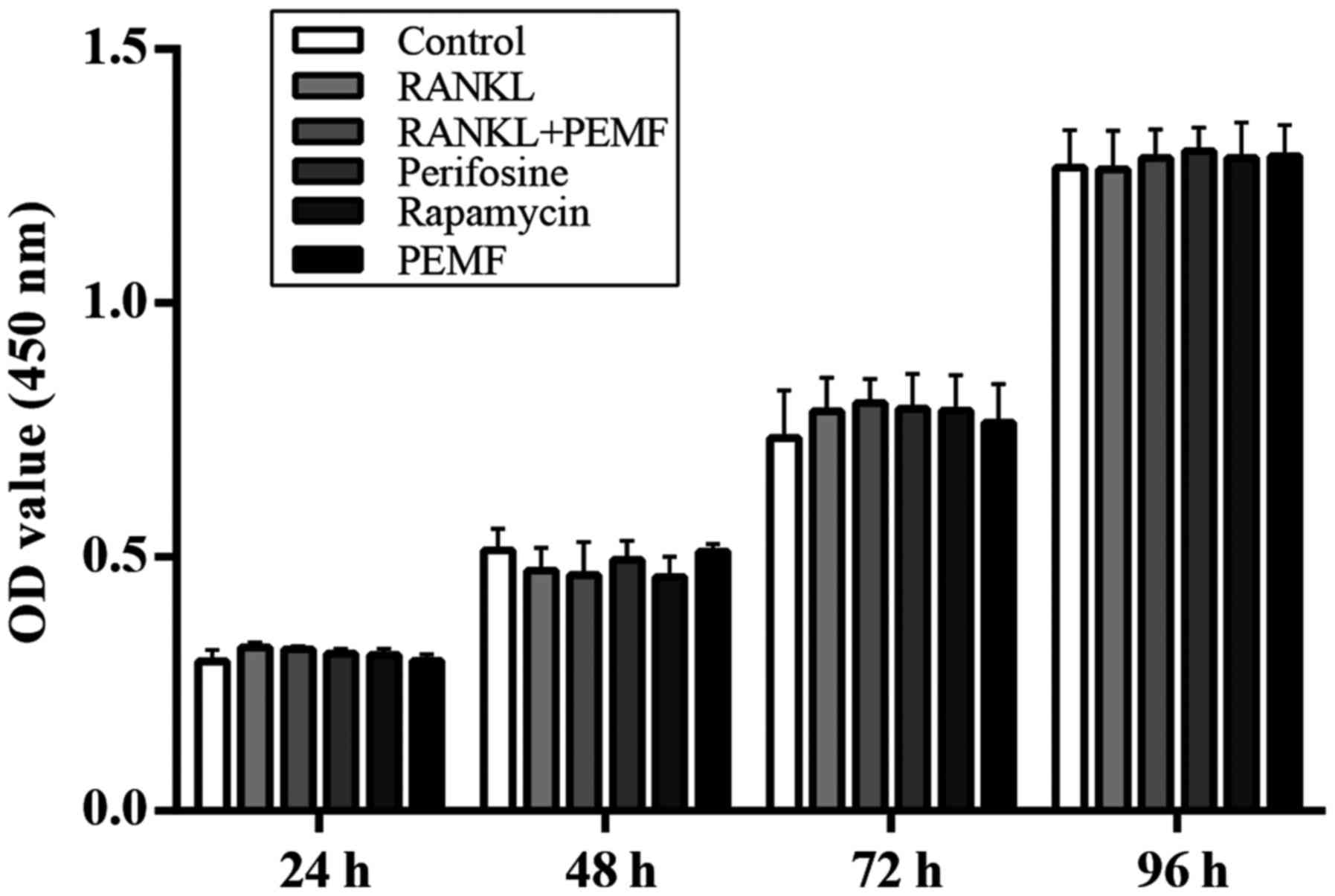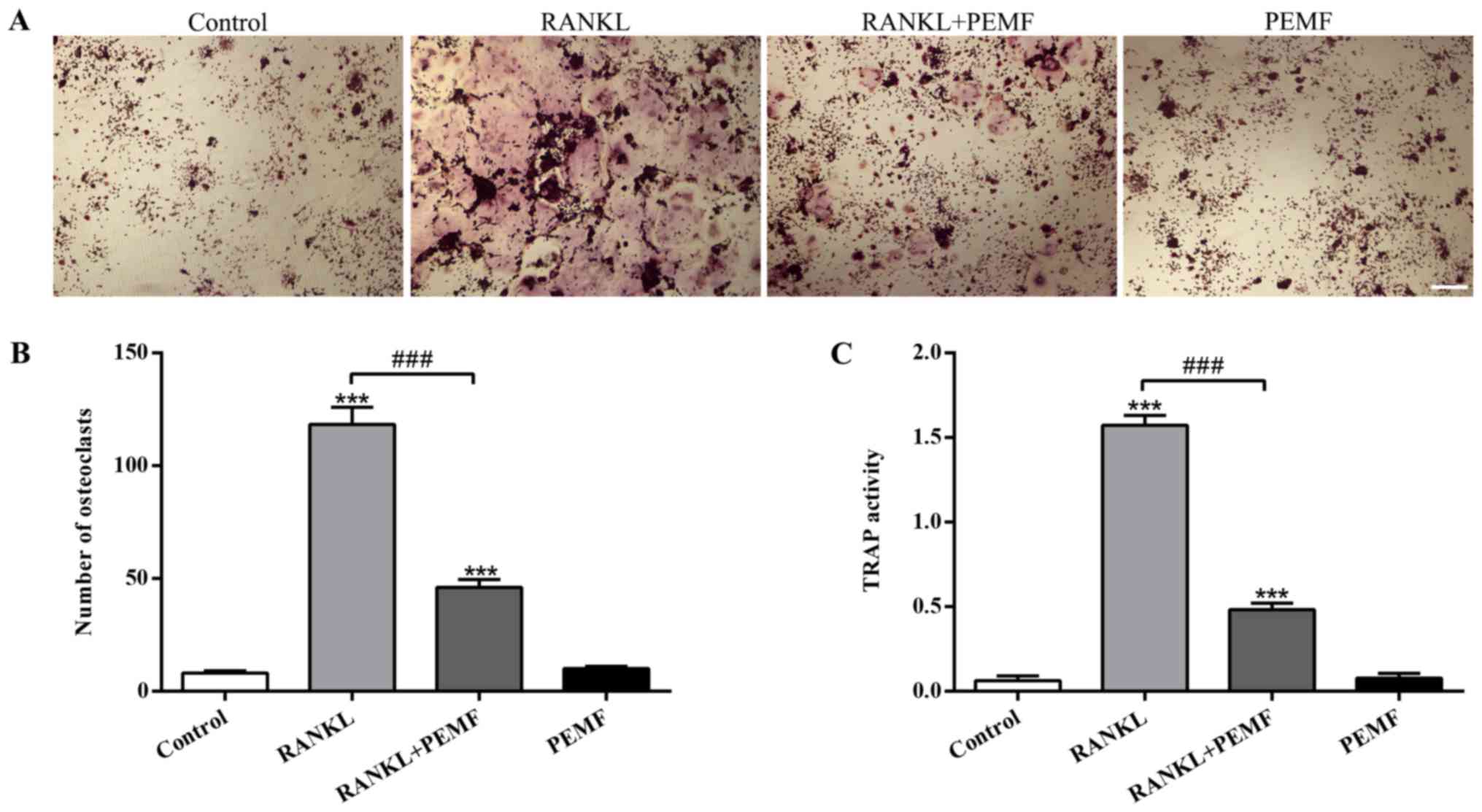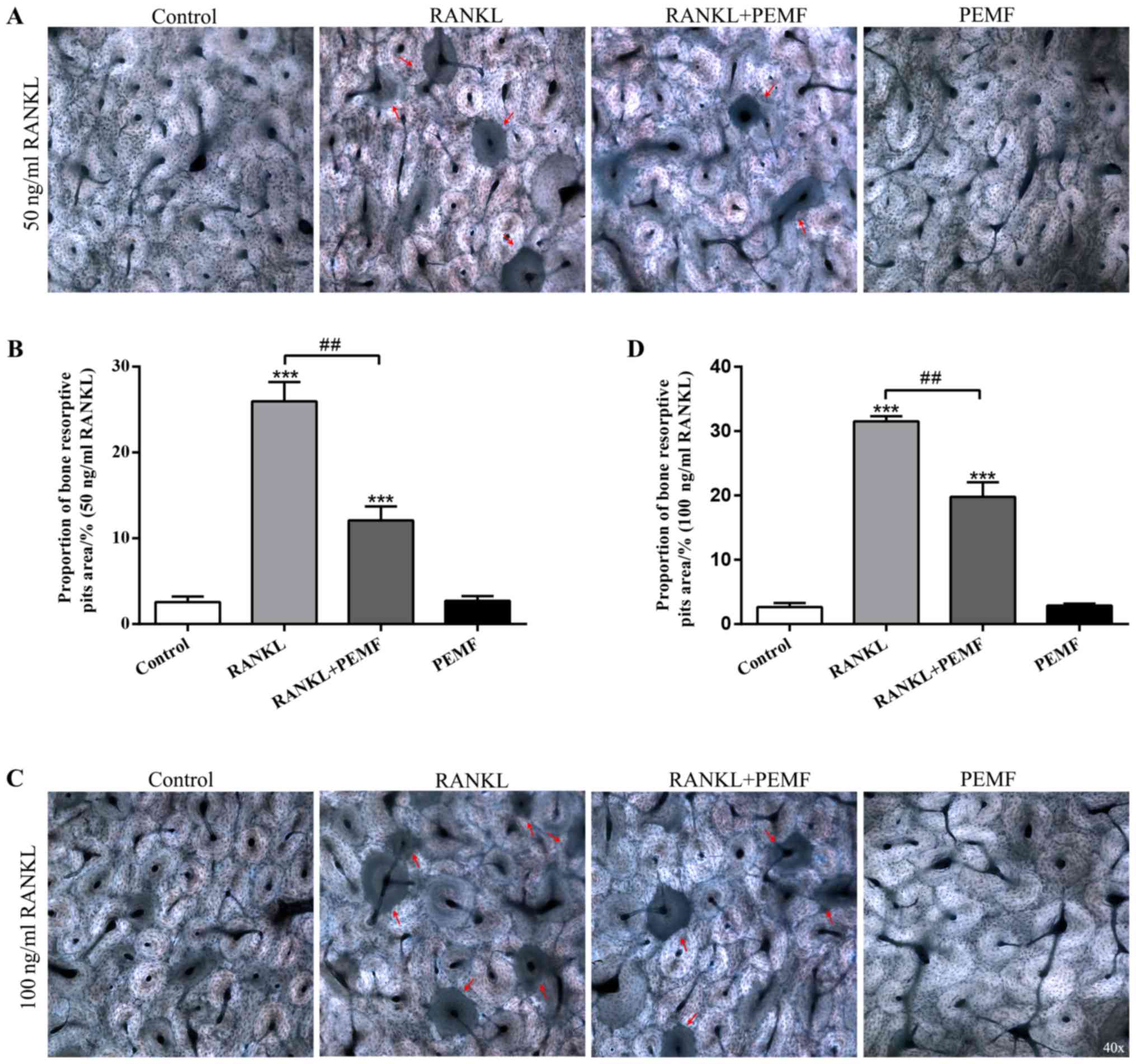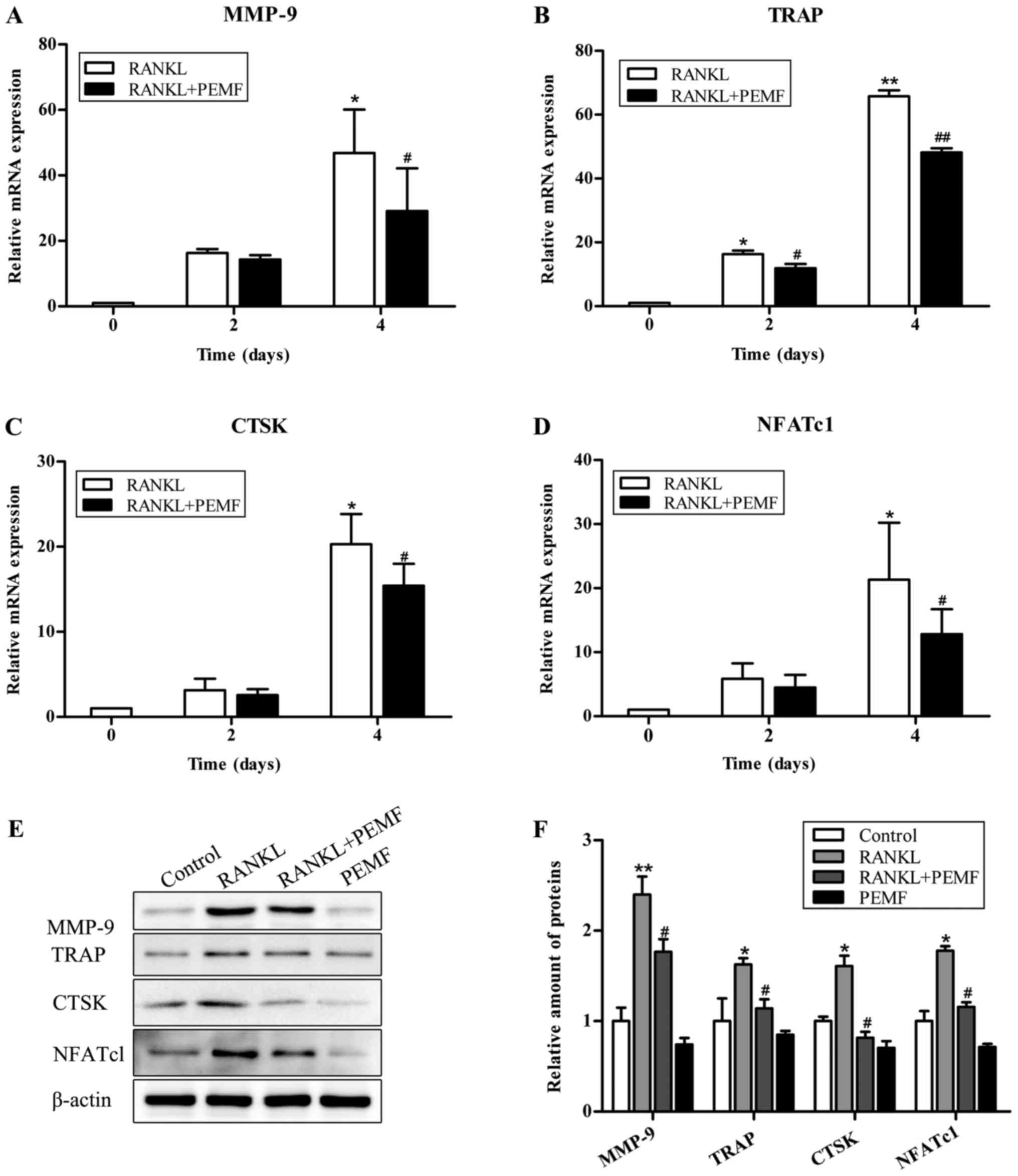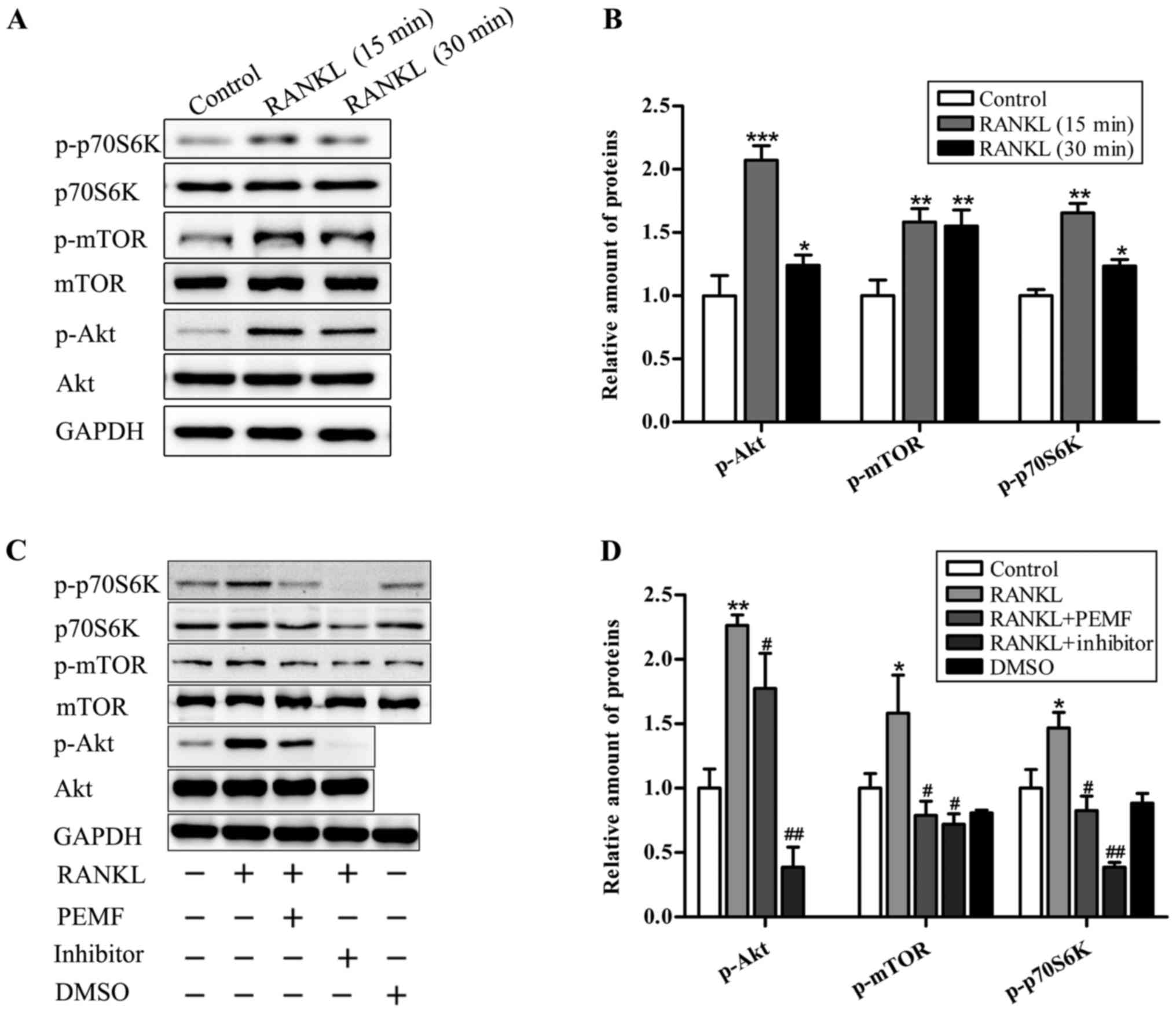Pulsed electromagnetic fields inhibit osteoclast differentiation in RAW264.7 macrophages via suppression of the protein kinase B/mammalian target of rapamycin signaling pathway
- Authors:
- Published online on: May 9, 2018 https://doi.org/10.3892/mmr.2018.8999
- Pages: 447-454
Abstract
Introduction
Osteoporosis is a common clinical disease exerting tremendous emotional, economic and social repercussions on patients and their families (1). Traditional pharmacological agents either promoting bone formation (e.g., parathyroid hormone) or inhibiting bone resorption (e.g., calcitonin, estrogen and bisphosphonate) may contribute to the prevention and reversal of osteoporosis to a certain extent; however, undesirable side effects, including metrorrhagia, esophagitis and mammary cancer, may occur simultaneously (2,3). Despite extensive research in experimental studies and preclinical trials of other novel pharmacological agents (e.g., denosumab, odanacatib and saracatinib), the potential mechanisms and possible side effects are not fully understood (4–6). Bonnick et al (7) found that odanacatib is a selective cathepsin K inhibitor being developed for the treatment of osteoporosis, but it increased the risk of atrial fibrillation and stroke. Furthermore, certain drugs are too expensive for patients to afford due to the long courses of drug treatment required.
Since the first application of pulsed electromagnetic fields (PEMFs) in accelerating clinical bone fracture healing in 1974 (8,9), the biological effects of PEMFs have gained considerable attention in orthopaedic research. Over the past four decades, studies regarding electromagnetic fields on different cells and animals have been extensively described. Accumulating evidence has revealed that PEMF stimulation potently promotes osteogenesis and enhances bone mineralization both in vivo and in vitro (10–12). Other studies have indicated that electromagnetic field treatment exerts protective effects on human bone marrow mesenchymal stem cells (13). Kang et al (14) suggested that the osteogenic differentiation of adipose-derived stem cells and bone regeneration is accelerated by PEMF stimulation. He et al (15) demonstrated that PEMFs significantly reduce the number of osteoclast-like cells in the culture with macrophage colony stimulating factor (M-CSF) and receptor activator of nuclear factor-κB ligand (RANKL), which indicates the potential role of PEMFs in osteoporosis. Despite the considerable beneficial effects of PEMF on osteoporosis (16,17), the underlying mechanism remains to be fully elucidated, which may impose restrictions for the clinical application of PEMFs.
The pivotal role of osteoclasts in bone defects and osteoporosis have resulted in their becoming a key therapeutic target in osteoporosis (18). Previous studies have investigated the effects of PEMFs on osteoblasts and osteoclasts. The results have demonstrated that PEMFs inhibit the differentiation of osteoclasts and facilitate the formation of osteoblasts, the underlying mechanisms of which are different (19,20). The promotion of osteoblast differentiation by PEMFs is primarily focused on the bone morphogenetic protein and the Wnt/β-catenin signaling pathways, the activation of which facilitates osteoblast differentiation, and improves bone microstructure and strength (21,22). Various studies have suggested that PEMF may suppress osteoclast differentiation by regulating certain pathways in the RANK/RANKL/osteoprotegerin (OPG) signaling system (23), of which the protein kinase B (Akt)/mammalian target of rapamycin (mTOR) signaling pathway may be key (24). The present study aimed to elucidate the effects of PEMFs on RANKL-induced osteoclast differentiation from RAW264.7 macrophages and to explore the potential mechanisms involving the intracellular Akt/mTOR signaling pathway during this process.
Materials and methods
Cell culture and reagents
RAW264.7 cells were purchased from the American Type Culture Collection (Manassas, VA, USA). Cells were cultured in Dulbecco's modified Eagle's medium (DMEM; Thermo Fisher Scientific, Inc., Waltham, MA, USA; 4.500 mg/l D-glucose) supplemented with 10% fetal bovine serum (FBS; Gibco; Thermo Fisher Scientific, Inc.) for maintaining cell growth or in α-minimum essential medium (α-MEM; Gibco; Thermo Fisher Scientific, Inc., 1.000 mg/l D-glucose) supplemented with 10% FBS (Gibco; Thermo Fisher Scientific Inc.) for inducing cell differentiation, at 37°C in an environment containing 5% CO2. Recombinant mouse RANKL was obtained from R&D Systems (Minneapolis, MN, USA). Cell Counting Kit-8 (CCK-8) was purchased from Dojindo Molecular Technologies, Inc. (Kumamoto, Japan) and a tartrate-resistant acid phosphatase (TRAP) staining kit was purchased from Sigma-Aldrich; Merck KGaA (Darmstadt, Germany). Bovine bone slices were obtained from Third Military Medical University (Chongqing, China). cDNA Synthesis kits and All-in-One qPCR Mix were purchased from GeneCopoeia (Rockville, MD, USA). Antibodies against Akt, mTOR, ribosome S6 protein kinase (p70S6K), phosphorylated (p)-Akt, p-mTOR, p-p70S6K, nuclear factor of activated T-cells 1 (NFATc1), GAPDH and anti-rabbit horseradish peroxidase-conjugated antibodies were purchased from Cell Signaling Technology, Inc. (Danvers, MA, USA). Antibodies against matrix metallopeptidase (MMP)-9, TRAP and cathepsin K (CTSK) were purchased from Proteintech (Rocky Hill, NJ, USA). Inhibitors perifosine and rapamycin were purchased from Selleck Chemicals (Houston, TX, USA).
PEMF stimulation
To explore the effects of PEMFs on osteoclast differentiation, an electromagnetic field device was used, as previously described (25). Based on previous studies and the preliminary work of the present study, the appropriate parameters of PEMFs with 50 Hz and 1 mT were selected. Briefly, RAW264.7 macrophages were exposed to PEMFs in a system formed by Helmholtz coils (inner diameter of ~30 cm) that oriented to produce a sinusoidal PEMF with 50 Hz and 1 mT. All studies were conducted in a humidified incubator at 37°C under 5% CO2 for 4 h per day. The control group was cultured in a separate incubator under the same conditions without exposure to PEMFs. Medium was changed every 2 days.
CCK-8 assay for cell viability
Cell viability was tested using a CCK-8 assay. RAW264.7 macrophages were seeded at a density of 2×103 cells/well onto a 96-well culture plate in DMEM. Following the overnight incubation for attachment to the wall, the culture medium was changed to α-MEM and cells were cultured further in a humidified incubator with RANKL (50 ng/ml), RANKL (50 ng/ml) + PEMF, perifosine (2.5 µM), rapamycin (1 µM) and PEMFs for 4 days. A CCK-8 assay was carried out every 24 h (24, 48, 72 and 96 h) according to the manufacturer's protocol. CCK-8 reagent was added to each well, followed by incubation for 4 h, prior to absorbance being measured at a wavelength of 450 nm using a microplate reader.
TRAP staining and activity
RAW264.7 macrophages were seeded at a density of 1.5×104 cells/well onto a 24-well culture plate in DMEM overnight. Then, the medium was changed to α-MEM with the addition of RANKL (50 ng/ml) or processed with RANKL + PEMF (50 Hz, 1 mT) for 4 days to induce osteoclast differentiation. Then, cells were fixed with 3.7% formaldehyde for 30 sec and were stained with TRAP staining solution (45 ml deionized water, 0.5 ml Fast Garnet GBC Base solution, 0.5 ml sodium nitrite solution, 0.5 ml naphthol AS-BI phosphate solution, 2 ml acetate solution and 1 ml tartrate solution) according to the manufacturer's protocol. TRAP-positive osteoclasts containing three or more nuclei were counted in 12 wells/plate. This counting was repeated five times. TRAP activity was measured from osteoclast culture supernatants using a TRAP Staining kit. In brief, supernatants (30 µl per well) were incubated with the chromogenic substrates (170 µl) in a tartrate-containing buffer for 3 h at 37°C. Then, absorbance was measured to determine TRAP activities at a wavelength of 540 nm (26).
Bone resorption assay
Cells were seeded at a density of 1.5×104 cells/well onto a 48-well plate covered with bovine bone slices. RAW264.7 macrophages were then induced with RANKL (50 or 100 ng/ml) for 8 days with or without PEMF exposure. Following 8 days of culture, the bovine bone slices were washed with 5% sodium hypochlorite solution and toluidine blue staining was performed. To quantify the osteoclastic bone resorption, the resorbed pit areas were confirmed under a light microscope and identified by Image pro-plus (version 6.0).
Reverse transcription-quantitative polymerase chain reaction (RT-qPCR) analysis
Cells were washed with DPBS, and total RNA was extracted using 1 ml TRIzol reagent. Samples homogenized in TRIzol reagent were then extracted using 0.2 ml chloroform. Following centrifugation at 10,000 rpm at 4°C for 15 min, the supernatant containing RNA was transferred into a new vial and RNA was precipitated by adding 500 µl isopropanol. The supernatant was discarded following incubation for 10 min and centrifugation at 10,000 rpm for 10 min. The pellet was washed with 1 ml 75% ethanol and centrifuged for 5 min at 7,000 rpm. The supernatant was then discarded and the pellet was dried. After adding 30 µl diethylpyrocarbonate (DEPC)-treated water, the pellet was dissolved at 85°C for 10 min. Total RNA (1 µg) was then reverse transcribed with the cDNA synthesis kit to obtain cDNA, using the following temperature protocol: 37°C for 60 min, followed by 98°C for 5 min. qPCR was conducted in an ABI StepOnePlus Real-time PCR system (Applied Biosystems; Thermo Fisher Scientific, Inc.) using ALL-in-One qPCR Mix. The thermocycling conditions were as follows: 95°C for 10 min followed by 95°C for 10 sec, then 45 cycles of 60°C for 20 sec and 72°C for 15 sec. The relative expression of genes was calculated using the 2−ΔΔCq method and all results were normalized to GAPDH (27). The sequences of the forward and reverse primers were as follows: GAPDH, ACCACAGTCCATGCCATCAC and TCCACCACCCTGTTGCTGTA; NFATc1, GGTAACTCTGTCTTTCTAACCTTAAGCTCandGTGATGACCCCAGCATGCACCAGTCACAG; MMP-9, CGCTCATGTACCCGCTGTAT and TGTCTGCCGGACTCAAAGAC; TRAP, CTGGAGTGCACGATGCCAGCGACA and TCCGTGCTCGGCGATGGACCAGA; and CTSK, AGGCAGCTAAATGCAGAGGGTACA and ATGCCGCAGGCGTTGTTCTTATTC.
Western blotting
Cells were treated for the indicated time with various treatments. Then, western blotting was performed according to standard procedures. Cells were rinsed with PBS and harvested in radioimmunoprecipitation assay buffer containing protease and phosphatase inhibitors. Following incubation on ice for 30 min, the cell lysates were centrifuged at 12,000 rpm for 20 min and protein precipitations were collected. Proteins (20 ug) were separated on SDS-PAGE (8–12% gels) and devolved to nitrocellulose membranes. The membranes were blocked with 5% bovine serum albumin in TBST containing 0.1% Tween-20 at room temperature for an hour and probed successively with rabbit primary antibodies against the following: MMP-9 (1:1,000), TRAP (1:1,000), CTSK (1:500), NFATc1 (1:1,000), Akt (1:1,000), p-Akt (1:2,000), mTOR (1:1,000), p-mTOR (1:1,000), p70S6K (1:1,000), p-p70S6K (1:1,000), β-actin (1:1,000) and GAPDH (1:2,000) primary antibodies overnight at 4°C. Horseradish peroxidase-conjugated goat anti-rabbit IgG antibodies were used as secondary antibodies at room temperature for an hour. The signals were detected by exposure in an enhanced chemiluminscence system system and then analyzed using ImageJ software (version 1.46).
Statistical analysis
All data are expressed as the mean ± standard deviation. Statistical analyses were performed using Student's t-tests or one-way analysis of variance, followed by Student-Newman-Keuls post hoc test, using SPSS software, version 20.0 (IBM Corp., Armonk, NY, USA). P<0.05 was considered to indicate a statistically significant difference.
Results
Effect of PEMF on cell viability
To investigate whether RANKL, PEMF or pharmacological inhibitors influenced cell viability, a CCK-8 assay was performed. RAW264.7 macrophages were cultured with different stimuli for 4 days. The 450 nm absorbance was detected every 24 h to assess cell viability post-incubation with the CCK-8 reagent. As presented in Fig. 1, over the four day period, there was no significant difference observed among the different groups, with respect to cell viability, suggesting that RANKL, PEMF and pharmacological inhibitors had no cytotoxic effects on osteoclast precursor cells.
Effect of PEMF on osteoclast formation and TRAP activity
TRAP enzyme is highly expressed and secreted in mature osteoclasts, and functions as a secure indicator for osteoclast formation (28). To explore the influence of PEMF on osteoclast formation, TRAP staining and measurement of TRAP activity was conducted. Osteoclasts containing three or more nuclei were categorized as TRAP-positive cells. When treated with RANKL, the number of giant osteoclasts containing multiple nuclei was markedly increased compared with the control (Fig. 2A). However, the number of multinuclear osteoclasts induced by RANKL was significantly decreased by PEMF application (Fig. 2B). Results of the TRAP activity assay also demonstrated that RANKL treatment resulted in enhancement of TRAP activity, while this facilitating effect was attenuated by PEMF application (Fig. 2C). The suppression of multinucleated osteoclast formation and TRAP activity during osteoclast differentiation suggested that PEMF decreased osteoclastogenesis via osteoclast precursor (RAW264.7 macrophages) fusion inhibition.
Effect of PEMF on osteoclastic bone resorption in vitro
Mature osteoclasts function to absorb bone matrix, resulting in an irregular surface of the matrix (29). The present study investigated whether PEMF could inhibit osteoclastic bone resorption in vitro (Fig. 3). RANKL-induced osteoclasts resulted in resorption pits on bovine bone slices (Fig. 3A). The data also revealed that bone resorptive pit areas increased with a higher concentration of RANKL (100 ng/ml; Fig. 3C). However, the bone resorption of osteoclasts induced by RANKL was markedly attenuated by exposure to 50 Hz PEMFs (Fig. 3B and D), which was consistent with the inhibitory effects of PEMFs on osteoclast formation, and in turn implied the active bone resorption activity of multinucleated osteoclasts. These results indicated that PEMF repressed the bone resorption activity of osteoclasts in vitro.
Effect of PEMF on osteoclastic differentiation
To further elucidate the role of PEMF in osteoclast differentiation, the present study examined the expression of osteoclastic marker genes during osteoclastogenesis using RT-qPCR. The expression of NFATc1, one of the osteoclast-specific transcription factors, as well as that of three other osteoclastic specific genes, MMP-9, TRAP and CTSK, was upregulated upon treatment with RANKL. However, this was significantly decreased by the addition of PEMF (Fig. 4A-D). This PEMF-regulated expression of osteoclastogenic markers were further confirmed by western blotting (Fig. 4E and F). Collectively, these data supported the inhibition of osteoclast formation by PEMFs.
PEMFs inhibit RANKL-induced osteoclastogenesis via regulation of the Akt/mTOR signaling pathway
To evaluate the effect of PEMF on RANKL signaling activation following RANKL treatment in RAW264.7 cells, proteins associated with the Akt/mTOR signaling pathway, including Akt, mTOR and p70S6K, were examined by western blotting. As demonstrated in Fig. 5A, the data revealed that there was no significant difference among groups in the total protein expression levels of Akt, mTOR and p70S6K. However, the expression of p-Akt, p-mTOR and p-p70S6K, the type of modified protein with a crucial role in this signal transduction, was increased in response to RANKL treatment (Fig. 5B). Conversely, the upregulation of these proteins induced by RANKL was suppressed by pharmacological inhibitors, perifosine (Akt inhibitor) and rapamycin (mTOR and p70S6K inhibitor). In accordance with the inhibitory effects of antagonists, PEMF application also distinctly decreased RANKL-induced upregulation of these phosphorylated proteins (Fig. 5C and D), suggesting the possibility that PEMF may inhibit RANKL-induced osteoclastogenesis by suppression of the Akt/mTOR signaling pathway./
Discussion
Osteoclasts, the specialized cells derived from monocyte/macrophage haematopoietic lineage, develop and adhere to bone matrix, and subsequently secrete acid and lyase that degrade it in an extracellular compartment (24). Due to excess osteoclastic activity, bone resorption is accelerated resulting in an imbalance of bone remodeling, leading to osteoporosis and other associated diseases, particularly in the elderly population (30). Osteoporosis is an important issue in orthopedics. PEMF has been successfully applied to various diseases in several basic research experiments, most commonly including senile osteoporosis, osteoarthritis and cancer bone metastasis. However, few studies have reported the effects of PEMF on osteoclast differentiation and formation, and the associated signaling pathway mechanisms (31,32). A previous study demonstrated that PEMF exposure markedly inhibited RANKL-induced osteoclast formation from RAW264.7 macrophages, and that this effect resulted from suppression of intracellular Akt and mTOR protein phosphorylation.
RANKL and M-CSF are necessary for the differentiation and maturation of osteoclasts, which then activate the RANK receptor on the surface of haematopoietic precursor cells (33). Macrophage RAW264.7 cells are capable of secreting adequate M-CSF independently to support their osteoclast differentiation. This cell line is known to be suitable for investigating RANKL-induced osteoclast formation in vitro due to the high levels of RANK it produces (34). The present study demonstrated that RANKL led to a significant increase in the number of osteoclasts, and the mRNA and protein expression of osteoclastic markers throughout the 4 day experimental period. However, the marked increases in the number of multinucleated giant osteoclasts and the expression of osteoclastic-specific marker were suppressed by PEMF exposure during osteoclastogenesis. Furthermore, it was demonstrated that PEMFs inhibited RANKL-induced Akt and mTOR activation. Therefore, these results revealed that PEMF exposure reversed RANKL-induced osteoclast differentiation and formation via suppression of the Akt/mTOR signaling pathway.
RANKL, a tumor necrosis factor (TNF) family member, serves an important role in osteoclast survival, cytoskeletal reorganization, bone resorption and osteoclast differentiation. Activation of RANK by its ligand is crucial for osteoclastogenesis. Wong et al (35) demonstrated that RANKL activates the anti-apoptotic serine/threonine kinase Akt through a signaling complex involving TNF receptor-associated factor (TRAF) 6 and c-Src in osteoclasts. Akt, also known as protein kinase B, has been demonstrated to be vital in osteoclast differentiation (36). Furthermore, Akt functions to phosphorylate mTOR, a protein involved in cell growth, homeostasis and cell differentiation via the phosphatidylinositol 3-kinase (PI3K)/Akt signaling pathway (37). Inhibition of mTOR by rapamycin, an mTOR inhibitor, decreases the number of multinucleated TRAP-positive osteoclasts in the chondro-osseous junction in rats (38). Following the activation of Akt and mTOR protein, the downstream signaling pathways are activated and osteoclast differentiation is promoted.
Despite the future potential of arising therapeutic strategies revealed by these studies, there are also limitations. The specific mechanism by which PEMF inhibits the Akt/mTOR signaling pathway remains unclear. One possibility is that PEMF influences the Src signaling pathway, which is a significant RANK signaling network in osteoclasts. Src, a signaling protein required for osteoclast activation, has also been revealed to bind to TRAF6 and allow RANK-mediated signaling to proceed through lipid kinase phosphatidylinositol 3 OH kinase and serine/threonine protein kinase Akt (39). Src has an important role in the signal transduction of the RANK/RANKL/OPG signaling network. The activation or inhibition of Src signaling pathways may influence cell proliferation, differentiation, motility and cytoskeletal rearrangement (24). However, further investigation is required to elucidate the specific underlying mechanisms and associations.
In conclusion, the results of the present study demonstrated that PEMF (50 Hz, 1 mT) inhibited osteoclast differentiation from RAW264.7 macrophages by inhibiting the Akt/mTOR signaling pathway. Therefore, PEMF may be an effective non-invasive method in the treatment of a wide range of osteoclast-associated diseases. Understanding the anti-osteoclastogenesis mechanism of PEMF may be helpful for the efficient use of PEMF in osteoporosis-associated diseases, both in animal experiments and as a future therapeutic strategy.
Acknowledgements
The authors gratefully acknowledge the technical assistance of Dr Hui Zhou and Mr Zhonghao Li of the Department of Pathophysiology, Key Laboratory for Shock and Microcirculation Research of Guangdong, Southern Medical University (Guangzhou, China). The authors would also like to thank the Department of Pathophysiology, Southern Medical University (Guangzhou, China) for allowing the use of the laboratory.
Funding
No funding was received.
Availability of data and materials
All data generated or analyzed during this study are included in this published article.
Authors' contributions
YL, JS, HX, QY, MZ, JT designed the experiments. YL performed the major experiments and data analysis. JS, HX performed a part of the experiments. YL drafted the manuscript. All authors read and approved the final version of the manuscript.
Ethics approval and consent to participate
Not applicable.
Consent for publication
Not applicable.
Competing interests
The authors declare that they have no competing interests.
References
|
Liu W, Yang LH, Kong XC, An LK and Wang R: Meta-analysis of osteoporosis: Fracture risks, medication and treatment. Minerva Med. 106:203–214. 2015.PubMed/NCBI | |
|
Musette P, Brandi ML, Cacoub P, Kaufman JM, Rizzoli R and Reginster JY: Treatment of osteoporosis: Recognizing and managing cutaneous adverse reactions and drug-induced hypersensitivity. Osteoporos Int. 21:723–732. 2010. View Article : Google Scholar : PubMed/NCBI | |
|
Gartlehner G, Patel SV, Feltner C, Weber RP, Long R, Mullican K, Boland E, Lux L and Viswanathan M: Hormone therapy for the primary prevention of chronic conditions in postmenopausal women: Evidence report and systematic review for the US preventive services task force. JAMA. 318:2234–2249. 2017. View Article : Google Scholar : PubMed/NCBI | |
|
Hadji P, Papaioannou N, Gielen E, Tepie Feudjo M, Zhang E, Frieling I, Geusens P, Makras P, Resch H, Möller G, et al: Persistence, adherence, and medication-taking behavior in women with postmenopausal osteoporosis receiving denosumab in routine practice in Germany, Austria, Greece and Belgium: 12-month results from a European non-interventional study. Osteoporosis Int. 26:2479–2489. 2015. View Article : Google Scholar | |
|
Bone HG, Dempster DW, Eisman JA, Greenspan SL, McClung MR, Nakamura T, Papapoulos S, Shih WJ, Rybak-Feiglin A, Santora AC, et al: Odanacatib for the treatment of postmenopausal osteoporosis: Development history and design and participant characteristics of LOFT, the long-term Odanacatib fracture trial. Osteoporosis Int. 26:27212015. View Article : Google Scholar | |
|
Hannon RA, Clack G, Rimmer M, Swaisland A, Lockton JA, Finkelman RD and Eastell R: Effects of the Src kinase inhibitor saracatinib (AZD0530) on bone turnover in healthy men: A randomized, double-blind, placebo-controlled, multiple-ascending-dose phase I trial. J Bone Miner Res. 25:463–471. 2013. View Article : Google Scholar | |
|
Bonnick S, De Villiers T, Odio A, Palacios S, Chapurlat R, DaSilva C, Scott BB, Le Bailly De Tilleghem C, Leung AT and Gurner D: Effects of odanacatib on BMD and safety in the treatment of osteoporosis in postmenopausal women previously treated with alendronate: A randomized placebo-controlled trial. J Clin Endocrinol Metab. 98:4727–4735. 2013. View Article : Google Scholar : PubMed/NCBI | |
|
Bassett CA, Pawluk RJ and Pilla AA: Augmentation of bone repair by inductively coupled electromagnetic fields. Science. 184:575–577. 1974. View Article : Google Scholar : PubMed/NCBI | |
|
Bassett CA, Pawluk RJ and Pilla AA: Acceleration of fracture repair by electromagnetic fields. A surgically noninvasive method. Ann N Y Acad Sci. 238:242–262. 1974. View Article : Google Scholar : PubMed/NCBI | |
|
Wang T, Wang P, Cao Z, Wang X, Wang D, Shen Y, Jing D, Luo E and Tang W: Effects of BMP9 and pulsed electromagnetic fields on the proliferation and osteogenic differentiation of human periodontal ligament stem cells. Bioelectromagnetics. 38:63–77. 2017. View Article : Google Scholar : PubMed/NCBI | |
|
Zhou J, He H, Yang L, Chen S, Guo H, Xia L, Liu H, Qin Y, Liu C, Wei X, et al: Effects of pulsed electromagnetic fields on bone mass and Wnt/β-catenin signaling pathway in ovariectomized rats. Arch Med Res. 274–282. 2012. View Article : Google Scholar : PubMed/NCBI | |
|
Jing D, Zhai M, Tong S, Xu F, Cai J, Shen G, Wu Y, Li X, Xie K, Liu J, et al: Pulsed electromagnetic fields promote osteogenesis and osseointegration of porous titanium implants in bone defect repair through a Wnt/β-catenin signaling-associated mechanism. Sci Rep. 24:320452016. View Article : Google Scholar | |
|
Urnukhsaikhan E, Cho H, Mishig-Ochir T, Seo YK and Park JK: Pulsed electromagnetic fields promote survival and neuronal differentiation of human BM-MSCs. Life Sci. 151:130–138. 2016. View Article : Google Scholar : PubMed/NCBI | |
|
Kang KS, Hong JM, Seol YJ, Rhie JW, Jeong YH and Cho DW: Short-term evaluation of electromagnetic field pretreatment of adipose-derived stem cells to improve bone healing. J Tissue Eng Regen Med. 9:1161–1171. 2012. View Article : Google Scholar : PubMed/NCBI | |
|
He J, Zhang Y, Chen J, Zheng S, Huang H and Dong X: Effects of pulsed electromagnetic fields on the expression of NFATc1 and CAII in mouse osteoclast-like cells. Aging Clin Exp Res. 27:13–19. 2015. View Article : Google Scholar : PubMed/NCBI | |
|
Lei T, Liang Z, Li F, Tang C, Xie K, Wang P, Dong X, Shan S, Jiang M, Xu Q, et al: Pulsed electromagnetic fields (PEMF) attenuate changes in vertebral bone mass, architecture and strength in ovariectomized mice. Bone. 108:10–19. 2017. View Article : Google Scholar : PubMed/NCBI | |
|
Lin HY and Lin YJ: In vitro effects of low frequency electromagnetic fields on osteoblast proliferation and maturation in an inflammatory environment. Bioelectromagnetics. 32:552–560. 2011. View Article : Google Scholar : PubMed/NCBI | |
|
Zhang D, Huang Y, Huang Z, Zhang R, Wang H and Huang D: FTY-720P suppresses osteoclast formation by regulating expression of interleukin-6 (IL-6), interleukin-4 (IL-4) and matrix metalloproteinase 2 (MMP-2). Med Sci Monitor. 22:2187–2194. 2016. View Article : Google Scholar | |
|
Yang J, Zhang J, Ding C, Dong D and Shang P: Regulation of osteoblast differentiation and iron content in MC3T3-E1 cells by static magnetic field with different intensities. Biol Trace Elem Res. Oct 19–2017.(Epub ahead of print). doi: 10.1007/s12011-017-1161-5. | |
|
Barnaba SA, Ruzzini L, Di Martino A, Lanotte A, Sgambato A and Denaro V: Clinical significance of different effects of static and pulsed electromagnetic fields on human osteoclast cultures. Rheumatol Int. 32:1025–1031. 2012. View Article : Google Scholar : PubMed/NCBI | |
|
Xie YF, Shi WG, Zhou J, Gao YH, Li SF, Fang QQ, Wang MG, Ma HP, Wang JF, Xian CJ, et al: Pulsed electromagnetic fields stimulate osteogenic differentiation and maturation of osteoblasts by upregulating the expression of BMPRII localized at the base of primary cilium. Bone. 93:22–32. 2016. View Article : Google Scholar : PubMed/NCBI | |
|
Jing D, Li F, Jiang M, Cai J, Wu Y, Xie K, Wu X, Tang C, Liu J, Guo W, et al: Pulsed electromagnetic fields improve bone microstructure and strength in ovariectomized rats through a Wnt/Lrp5/β-catenin signaling-associated mechanism. PLoS One. 8:e793772013. View Article : Google Scholar : PubMed/NCBI | |
|
Chang K, Chang WH, Huang S, Huang S and Shih C: Pulsed electromagnetic fields stimulation affects osteoclast formation by modulation of osteoprotegerin, RANK ligand and macrophage colony-stimulating factor. J Orthop Res. 23:1308–1314. 2005. View Article : Google Scholar : PubMed/NCBI | |
|
Boyle WJ, Simonet WS and Lacey DL: Osteoclast differentiation and activation. Nature. 423:337–342. 2003. View Article : Google Scholar : PubMed/NCBI | |
|
Xu H, Zhang J, Lei Y, Han Z, Rong D, Yu Q, Zhao M and Tian J: Low frequency pulsed electromagnetic field promotes C2C12 myoblasts proliferation via activation of MAPK/ERK pathway. Biochem Biophys Res Commun. 479:97–102. 2016. View Article : Google Scholar : PubMed/NCBI | |
|
Park KH, Park B, Yoon DS, Kwon SH, Shin DM, Lee JW, Lee HG, Shim JH, Park JH and Lee JM: Zinc inhibits osteoclast differentiation by suppression of Ca2+-Calcineurin-NFATc1 signaling pathway. Cell Commun Signal. 11:742013. View Article : Google Scholar : PubMed/NCBI | |
|
Kapetanakis NI, Uzan C, Jimenez-Pailhes AS, Gouy S, Bentivegna E, Morice P, Caron O, Gourzones-Dmitriev C, Le Teuff G and Busson P: Plasma miR-200b in ovarian carcinoma patients: Distinct pattern of pre/post-treatment variation compared to CA-125 and potential for prediction of progression-free survival. Oncotarget. 6:36815–36824. 2015. View Article : Google Scholar : PubMed/NCBI | |
|
Halleen JM, Tiitinen SL, Ylipahkala H, Fagerlund KM and Vӓӓnӓnen HK: Tartrate-resistant acid phosphatase 5b (TRACP 5b) as a marker of bone resorption. Clin Lab. 52:499–509. 2006.PubMed/NCBI | |
|
Liu H, Li D, Liu S, Liu Z and Li M: Histochemical evidence of IGF2 mRNA-binding protein 2-mediated regulation of osteoclast function and adhesive ability. Histochem Cell Biol. 149:343–351. 2018. View Article : Google Scholar : PubMed/NCBI | |
|
Rachner TD, Khosla S and Hofbauer LC: Osteoporosis: Now and the future. Lancet. 377:1276–1287. 2011. View Article : Google Scholar : PubMed/NCBI | |
|
Liu HF, He HC, Yang L, Yang ZY, Yao K, Wu YC, Yang XB and He CQ: Pulsed electromagnetic fields for postmenopausal osteoporosis and concomitant lumbar osteoarthritis in southwest China using proximal femur bone mineral density as the primary endpoint: Study protocol for a randomized controlled trial. Trials. 16:2652015. View Article : Google Scholar : PubMed/NCBI | |
|
Muramatsu Y, Matsui T, Deie M and Sato K: Pulsed electromagnetic field stimulation promotes anti-cell proliferative activity in doxorubicin-treated mouse osteosarcoma cells. In Vivo. 31:61–68. 2017. View Article : Google Scholar : PubMed/NCBI | |
|
Visagie A, Kasonga A, Deepak V, Moosa S, Marais S, Kruger MC and Coetzee M: Commercial Honeybush (cyclopia spp.) tea extract inhibits osteoclast formation and bone resorption in RAW264.7 murine macrophages-an in vitro study. Int J Environ Res Public Health. 12:13779–13793. 2015. View Article : Google Scholar : PubMed/NCBI | |
|
Collin-Osdoby P and Osdoby P: RANKL-mediated osteoclast formation from murine RAW 264.7 cells. Methods Mol Biol. 816:187–202. 2012. View Article : Google Scholar : PubMed/NCBI | |
|
Wong BR, Besser D, Kim N, Arron JR, Vologodskaia M, Hanafusa H and Choi Y: TRANCE, a TNF family member, activates Akt/PKB through a signaling complex involving TRAF6 and c-Src. Mol Cell. 4:1041–1049. 1999. View Article : Google Scholar : PubMed/NCBI | |
|
Li L, Sapkota M, Gao M, Choi H and Soh Y: Macrolactin F inhibits RANKL-mediated osteoclastogenesis by suppressing Akt, MAPK and NFATc1 pathways and promotes osteoblastogenesis through a BMP-2/smad/Akt/Runx2 signaling pathway. Eur J Pharmacol. 815:202–209. 2017. View Article : Google Scholar : PubMed/NCBI | |
|
Navé BT, Ouwens M, Withers DJ, Alessi DR and Shepherd PR: Mammalian target of rapamycin is a direct target for protein kinase B: Identification of a convergence point for opposing effects of insulin and amino-acid deficiency on protein translation. Biochem J. 344:427–431. 1999. View Article : Google Scholar : PubMed/NCBI | |
|
Hsieh CJ, Kuo PL, Hou MF, Hung JY, Chang FR, Hsu YC, Huang YF, Tsai EM and Hsu YL: Wedelolactone inhibits breast cancer-induced osteoclastogenesis by decreasing Akt/mTOR signaling. Int J Oncol. 46:555–562. 2015. View Article : Google Scholar : PubMed/NCBI | |
|
Takeshita S: SHIP-deficient mice are severely osteoporotic due to increased numbers of hyperresorptive osteoclasts. Nat Med. 9:943–949. 2002. View Article : Google Scholar |



